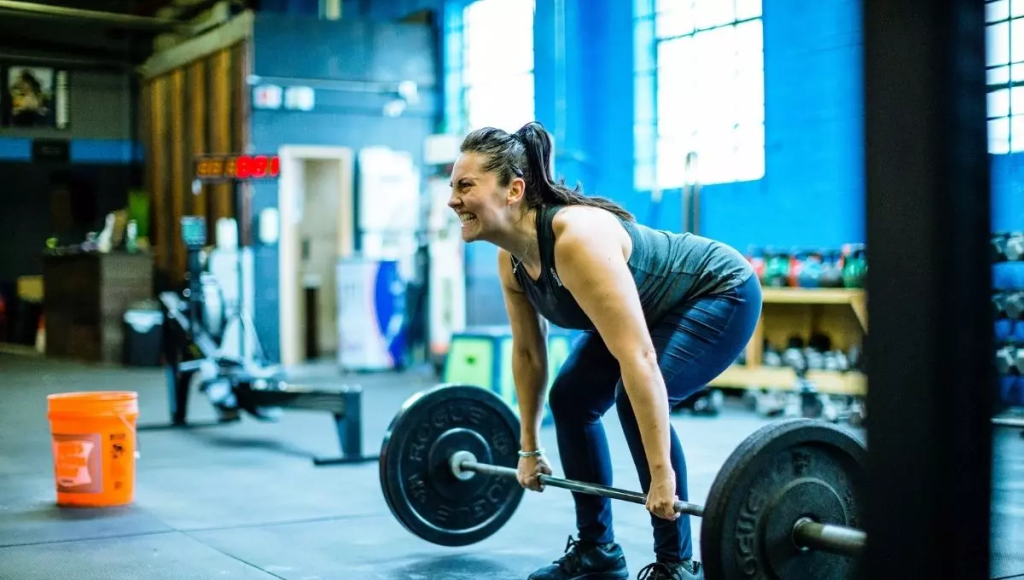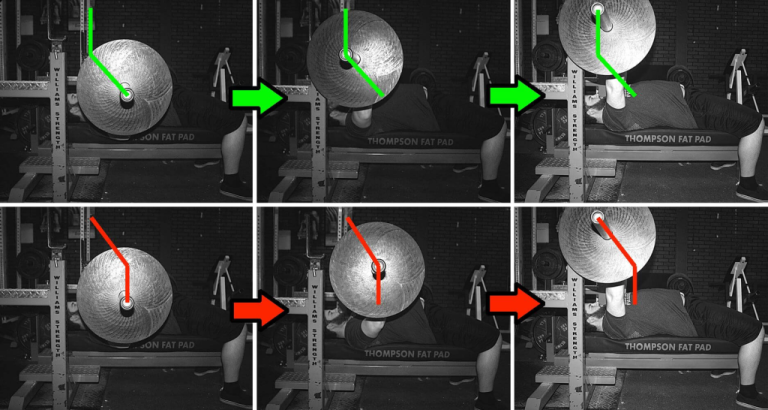The Key Barbell Exercises for CrossFit Competitors
Regardless of whether your fitness goals are to “rev up” your metabolism, increase strength or lean body mass through barbell exercises, decrease body fat, rehabilitate your back, improve athletic performance, or maintain functional independence as a senior, the Deadlift is a marked shortcut to that end.
To the detriment of millions, the Deadlift is infrequently used and seldom seen either by most of the exercising public and/or, believe it or not, by athletes. It might be that the Deadlift’s name has scared away the masses; its older name, “the Healthlift,” was a better choice for this perfect movement.
In its most advanced application the Deadlift is prerequisite to, and a component of, “the world’s fastest lift,” the Snatch, and “the world’s most powerful lift,” the Clean; but it is also, quite simply, no more than the safe and sound approach by which any object should be lifted from the ground.
DEADLIFT TECHNIQUE
- Feet under the hips weight on the heels.
- Barbell in hook grip (reversed grip if you are really only Deadlifting).
- Activate the body: make sure your hips are not too low (less active hams, etc) and not too high (less active quads etc). Set your lower back: pull all you got towards your spine (hollow back, chest “up” and neutral face) and retract the shoulders. Remember it is a total body lift.
- Hold your breath while you are lifting and “explode” from start. Open all angles at the same time and keep the barbell glued to your body (pull the barbell back) during the lift.
- If you want to go touch and go for multiple reps exhale and inhale on top of the lift (full extension), push your butt back (close the hip) and DON’T lose tension at the bottom!
BARBELL EXERCISES: THE CLEAN
The Clean is simply pulling a load from the ground to the shoulders where frequently the object is being readied for lifting overhead.
With the Clean our body moves from standing over an object and pulling it upwards, to supporting the weight from underneath. Compare this to the Muscle-Up where we take ourselves from under an object to supporting ourselves over it.
In its finest expression the clean is a process by which the hips and legs launch a weight upward from the ground to about bellybutton height and then retreat under the weight with blinding speed to catch it before it has had the time to become a runaway train.
The movement finishes with the hips and legs again working by squatting the weight up to full extension.
The speed and force with which the Clean (and, yes, the Snatch) drives loads give it developmental properties that other barbell exercises cannot match.
Deadlifts, Squats, and Bench Presses will never approximate the speed and force, and consequently the power required for a Clean at larger loads. For this simple reason, while these are important movements, they are not peers of the Clean. Power is that important.
CLEAN TECHNIQUE
- Position your feet shoulder width apart. Grip the bar just past shoulder width. Keep your back straight.
- Align the bar over the balls of your feet. Drop your hips so your shoulders are directly above the barbell. Engage core. Pull your head up, look straight ahead and keep your arms straight.
- Start lifting the barbell. Push the feet against the floor. Keep your core engaged. As the barbell passes the knees, pull it back towards your legs. Stay connected to it, keep it close to the body. Keep your arms straight and midline tight.
- The lift starts slowly and accelerates (after it passes the knees) into a quick, explosive movement and full-body extension.
- When you lift the barbell to the mid/upper thigh, explosively extend your hips. Shrug your shoulders, elbows should be bend outward. Aim to keep the bar close to the body as much as possible. Your goal should be a full hip extension.
- Shrug your shoulders, pull your body underneath into the front squat position to receive the bar on your shoulders. Lift your elbows up, push your shoulder forwards and slightly up. Stand up.
BARBELL EXERCISES: THE JERK
The jerk moves the barbell from the shoulders to an overhead locked-arm position in a single explosive movement.
The barbell is driven off the shoulders with a violent dip-drive. In the split second that the upward drive of the hips and shoulders make the barbell weightless, the athlete drives the body until the bar is fully locked out overhead.
The finished position can be in a split position or in a squat position. In competition, the Jerk is always paired with the Clean, and the lifter must complete both together for a successful lift.
ERK TECHNIQUE
- After standing up from the Front Squat, adjust the barbell into the Jerk rack position.
- Recover, breathe and align your balance towards the heels.
- Bend your knees and hips, keep your torso straight.
- Explosively extend and drive from the ground to thrust the bar upwards above the head.
- Feet split, elbows locked, core is engaged and the bar is received overhead. Recover to a full standing position
BARBELL EXERCISIES: THE PUSH PRESS
This lift is an enormous aid to developing the amount of power you are able to generate. Additionally, the advanced elements of the progression – the Push Press and Jerk – train for and develop power and speed. It´s about getting the bar from your shoulders into an overhead position with the help of a dive.
PUSH PRESS TECHNIQUE
- Secure the bar in the Jerk rack position with the feet at approximately hip-width and toes turned out slightly.
- Keep the weight balanced on the heels while maintaining full foot contact with the floor.
- Bend slightly at the knees only, keeping the trunk vertical and the weight on the heels.
- Transition immediately at the bottom of this dip and drive aggressively with the legs against the floor to accelerate the barbell upward.
- As you finish the extension of the legs, begin pushing against the bar with the arms, keeping the knees straight and immediately drop back to flat feet.
- Pull the head back out of the way of the bar to clear a direct path, and push the bar into a fully locked overhead position behind the neck as you would in the jerk.
- As the bar leaves the shoulders, spread the elbows to move them under the bar as soon as possible, and bring the head forward through the arms as the bar passes.
BARBELL EXERCISES: THE FRONT SQUAT
The Front Squat is a Squat with the addition of a loaded barbell to the front of the body. The barbell is supported by the torso in the front rack position.
FRONT SQUAT TECHNIQUE
- SET-UP
Shoulder-width stance. Hands just outside of shoulders. Loose, fingertip grip on the bar. Elbows high (upper arm parallel to the ground). - EXECUTION
Hips descend back and down. Lumbar curve maintained. Knees in line with toes. Hips descend lower than knees. Heels down. - FINISH
Complete at full hip and knee extension.
BARBELL EXERCISES: THE OVERHEAD SQUAT
This functional gem trains for the efficient transfer of energy from large to small body parts – the essence of sports movement. For this reason it is an indispensable tool for developing speed and power.
The Overhead Squat also demands and develops functional flexibility, and similarly develops the Squat by amplifying and cruelly punishing faults in squat posture, movement, and stability.
The Overhead Squat is to midline control, stability, and balance what the Clean and Snatch are to power – unsurpassed. Ironically, the overhead squat is exceedingly simple yet universally troublesome for beginners.
There are three common obstacles to learning the Overhead Squat.
The first is the scarcity of skilled instruction – outside of the Olympic lifting community most instruction on the Overhead Squat is laughably horrible and wrong – dead wrong.
The second is a weak squat – you need to have a rock-solid Squat to learn the overhead squat. We strongly recommend you review the December 2002 issue of the CrossFit Journal on squatting before attempting the overhead squat; you could save yourself a lot of time in the long run.
The third obstacle is starting with too much weight – you haven’t a snowball’s chance in hell of learning the overhead squat with a bar. You’ll need to use a length of dowel or plastic PVC pipe; use anything over five pounds to learn this move and your Overhead Squat will go no-where.
7. BARBELL EXERCISES: THE SNATCH
The full Snatch is one of the most complicated movements of any sport, and one of the hardest barbell exercises to do well. An athlete has to pull a weight upwards with force and speed, then completely reverse his mental keys to explode downward under the still-moving bar.
His foot placement, body positioning and lockout have to be precise when he hits the bottom or the bar will crash to the floor.
The Snatch is the ultimate in athleticism, and the pole vault is the only other movement that’s comparable in terms of concentration and difficulty. In that event, the athlete has to run at full speed and then direct that speed vertically. In the Snatch, the conversion is from moving upward bearing a heavy load to moving downward—a more severe shift.



